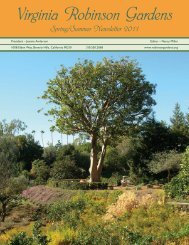Download - Virginia Robinson Gardens
Download - Virginia Robinson Gardens
Download - Virginia Robinson Gardens
Create successful ePaper yourself
Turn your PDF publications into a flip-book with our unique Google optimized e-Paper software.
Message from the County<br />
TIM LIndsaY – SUPerINTendenT OF roBInson <strong>Gardens</strong><br />
THE INTRIGUING WORLD OF SUCCULENTS<br />
at ROBINSON GARDENS. <br />
By Timothy L. Lindsay<br />
What are succulents anyway<br />
Succulents are drought tolerant<br />
plants that store water mainly<br />
in their leaves when water is<br />
amble and slowly utilize it during<br />
drought periods. In the animal<br />
kingdom, the camel, with its<br />
humps, shares this similar water<br />
storing strategy. The most<br />
familiar succulents are cacti.<br />
Virtually all cacti are succulents,<br />
but not all succulents are cacti. There are two difference<br />
groups of succulents; those that evolved in Africa and those<br />
that evolved in the Americas. New World plants called<br />
cacti all have spines. No succulents from the “Old World”<br />
(Africa) have spines. Increasingly over the past five years,<br />
succulents have been incorporated in public and private<br />
gardens, particularly in Southern California. It is not only the<br />
practicality of these marvelous plants that have brought them<br />
to such popularity; it is their intriguing colors and growth<br />
patterns. The same green rose shaped plant that appeals to<br />
the eye in miniature can grow to an enormous size, taking on<br />
an almost surrealistic quality.<br />
Professional landscapers<br />
have taken to this<br />
somewhat simple plant<br />
and utilized it in mass<br />
plantings to achieve<br />
dramatic contrast of<br />
color and form. In other<br />
VIRGINIA ROBINSON CAMELLIA instances, they highlight<br />
just a few succulents<br />
to make a bold architectural statement. Here at <strong>Robinson</strong><br />
<strong>Gardens</strong> succulents are most compatible with the water<br />
regime of the Italian Terrace garden, which receives only<br />
limited irrigation in the driest summer months.<br />
If succulents are given too much<br />
water, the plant cells burst, which<br />
then provides possible entry for<br />
disease organisms. On the other<br />
hand, succulents are very forgiving<br />
and will not bulk and shrivel when<br />
forgotten or neglected. In fact, if<br />
they are stressed from dehydration,<br />
once watered, they will be restored<br />
within 24 hours.<br />
Succulents are particularly<br />
effective when presented<br />
in pots. It is interesting to<br />
contrast the animate and<br />
inanimate in shape and texture.<br />
In the Italian Terrace Garden<br />
there is a marvelous Italian<br />
marble font planted with<br />
Kalanchoe thyrsiflora, ‘Bronze<br />
Sculpture.’ It is by far the most<br />
admired and photographed<br />
succulent in the garden.<br />
Another favorite is Kalanchoe<br />
pumila, because its color tonality makes concrete planters<br />
come alive. A succulent that is presented in mass is Aloe<br />
arborescence. This plant, as the name implies, becomes tree<br />
like and produces flowers that resemble red-hot pokers.<br />
Propagation is as easy as one,<br />
two, three. Asexual propagation<br />
is the method of choice with<br />
succulents. Simply cut off a stem<br />
with at least five nodes (places<br />
along stem where the leaves<br />
are attached), stick two of the<br />
nodes in a very gritty-sandy soil,<br />
and in just a few weeks, presto<br />
you have a clone of the parent<br />
plant. The key to growing succulents is to give them welldrained<br />
soil that is low in nutrients, provide lots of sun so<br />
they will color up, and avoid over watering. Ideally, succulents<br />
prefer daytime temperatures between 70ºF and about 85ºF<br />
and nighttime temperatures between 50ºF and 55ºF, although<br />
they can tolerate as low as 40°F.<br />
All images contained in this article were captured in the garden at <strong>Virginia</strong> <strong>Robinson</strong> <strong>Gardens</strong> on January 31, 2011 by Timothy Lindsay




